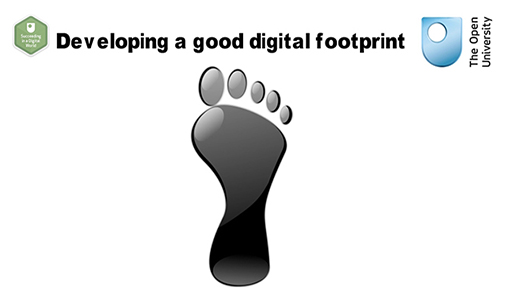2.1 On the road
Now that you’ve looked at some examples of digital footprints it’s time to take action. Before you do the activity, watch the video about improving your digital footprint.

Transcript: Video 2: Ten top tips to improve your digital footprint
Once you understand how important your digital footprint is, you can start to think about how you might improve the way in which you come across online. So let's see how you can do this. One of the first things you can do is to delete or deactivate all those online accounts that you don't use anymore. Doing this will mean that you won't need to worry about them, they can't be scammed, and it will leave you time to concentrate on the accounts that are most useful to you. There are tools available online that can help you do this.
For the accounts you choose to keep, think about who has access to them and filter out people you don't really know or no longer keep in contact with. For example, Facebook tends to be more personal, so you may only want family and friends to have access to the information you put there. However, if you use LinkedIn, you will want to connect with a professional network and be considered for jobs. If you want to be noticed, your settings should allow greater public access.
However, the information you provide is likely to be professional rather than personal. Now is the time to delete all those photographs that don't show you in a good light. Also, delete any posts that you're not proud of. Social network sites will provide you with information on how to do this. Sites like LinkedIn are great for showcasing your skills and knowledge.
If you want to get noticed, you'll need to ensure that you build up your profile to include your achievements, skills, qualifications, and knowledge. Consider your profile as your online CV. Employers or employment agencies frequently search LinkedIn for people with specific skills. When you think about the words you use on your profile, think about the words for which employers might search in order to find people with your skills.
There are a number of ways you can connect with others in your profession or field of interest. Twitter is a good place to find connections. Being active on Twitter will make it more likely that people will notice you. Stick to professional content and think about what your tweets are saying about you in a professional sense.
Blogs are also a great way of showcasing your knowledge. Think about starting your own professional blog, or find expert blogs that will keep you up to date. Adding your own comments will enable you to be part of the wider discussion. Discussion forums are also good places to meet professionals in your field. They are great places to learn from others and share good practice.
Activity 4 Developing your digital footprint
- Using the notes you made for the last activity, remind yourself of the steps Manuela, Michael and John have taken to reduce the negative impact of their digital footprint and to create a positive image, particularly for career purposes.
- Note one or two things you want to achieve when you’re online, for example, keeping up with friends and family, developing your business, keeping up to date with your interest or study topic.
- In your Digital plan, make a note of three things you can do to develop your footprint.
If you would like to, you could also go to the OU Library Facebook page [Tip: hold Ctrl and click a link to open it in a new tab. (Hide tip)] and provide a tip on how to improve your digital footprint.
It is worth thinking about who is shaping your digital footprint – is it you or your friends?
In the next section, you will explore what is meant by digital citizenship and how you can contribute positively online.
